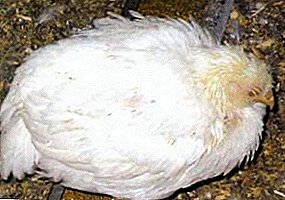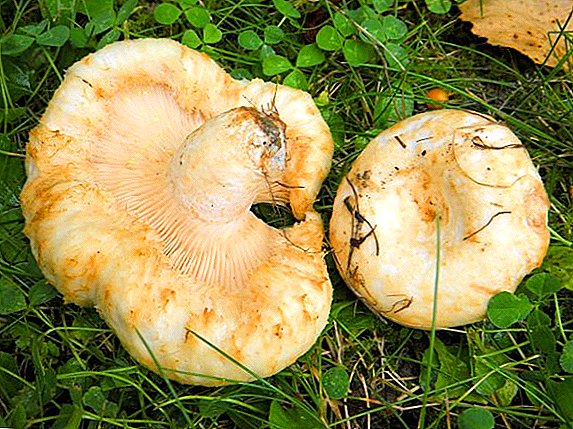
A chicken, like any other bird, is exposed to a variety of diseases, one of which is bronchopneumonia. In the autumn-winter period in birds, the inflammatory process affects the bronchi, lungs and trachea. It is important to identify the disease in a timely manner, otherwise you can destroy all the livestock.
What is bronchopneumonia in chickens
Bronchopneumonia is a type of pneumonia in which the lesion is inflicted not only on the lung tissue, but also on the adjacent structural elements of the bronchial tree. Inflammation is not focal in nature, it spreads within a segment, lobule or acini.
Forms of the disease
By severity, the disease in chickens is classified as follows.:
- Easy form. There is not pronounced symptoms of intoxication, febrile temperature, one lung segment is affected, respiratory failure is absent.
- Moderately severe. There is a moderately severe clinical picture, a rise in temperature of up to 38 degrees, pulmonary infiltration of 1-2 segments.
- Heavy. It is characterized by severe symptoms, the temperature is above 38 degrees, respiratory failure is traced.
Causative agents of infectious forms of pneumonia
If the cause of bronchopneumonia is not running bronchitis or another infectious disease, then the causative agent of the disease can not even be sought, since it is absent. Most often, the inflammatory process affects the respiratory system in chickens as a result of a long stay in the cold, a sharp temperature drop or living in an unheated house.
Inflammation can be affected by ordinary rain, under which chickens often fall. But pneumonia can be a consequence of bronchitis infectious etiology. In this case, the viral pathogen is transmitted from sick chickens to healthy ones through bedding, feed, or drinkers.
Attention! In chickens, it is important to carefully study the clinical picture so as not to miss the true cause of the pathological process.
Signs, Symptoms and Diagnosis
Recognize bronchopneumonia in chickens may by the following symptoms:
- rapid breathing;
- moist rales;
- the activity of chickens is sharply reduced, they sit all the time, they cannot move independently, eat food, drink water;
- heavy breathing, chicken breathing with open mouth.
In the absence of appropriate therapy, the young will begin to die already on the 2nd day.
Attention! It is possible to detect the disease in birds not only by signs, but also by conditions of detention.
For diagnosis, you can not resort to complex diagnostic methods. To establish bronchopneumonia can be on the external signs. To confirm the suspicions allow bioprobes.
Modern methods of treatment
If bronchopneumonia occurs in uncomplicated form, then it is easily treatable. It is important only to notice it in a timely manner and direct forces to fight it.
During treatment, adhere to the following plan.:
- Once the chickens have developed signs of the disease, spray Ashpieptol in the house.
There is no ready-made solution, so it needs to be prepared, based on the following recipe: dissolve 350 g of calcined salt in 2-3 liters of boiling water. In a separate container, dissolve 250 g of bleach in 7 liters of water. Wait 2 hours for the solutions to infuse. Combine them and dilute with water in a ratio of 1: 2.
- Using a spray bottle, spray the solution in the chicken coop.
- In combination with the spraying of the solution, give antibiotics: Penicillin, Terramycin, Norfloxacin. These drugs are ways to destroy most of the known pathogenic bacteria.
- For those who do not wish to give antibiotics to chickens, you can use mummy (honey mixture 1: 2). This method is also effective, but only the duration of therapy will be delayed for a month.
- If the chicken refuses to eat, you can give it pollen dissolved in a small amount of water. This method of feeding to produce using a pipette.
- Temporarily remove diseased birds from the main flock, disinfect the equipment, paying particular attention to containers for eating and drinking.
- Vitamins act as an aid. You can not ignore the fortification of the diet of poultry, especially during illness.
By performing these measures, after 7 days the birds will overcome the disease and will be able to return to the herd.
Prevention
Before you start chickens, it is important to warm the house to create full-fledged conditions for normal living of both young and adult chickens.
Indoors should not be drafts, sudden changes in temperature, dampness. Since bronchopneumonia most often affects young individuals, when they are kept the farmer must create the following conditions in the house:
- humidity - not less than 70%;
- the temperature is 3-4 degrees higher than that outside in the daytime.
Livestock to provide a full diet, filled with vitamins and useful trace elements. This will strengthen the immunity of birds and prevent the development of viral and infectious diseases.
What kind of economic harm does the disease bring to the farmer?
Most often, young chickens whose age has not reached 20 days are exposed to bronchopneumonia. Hardened animals rarely undergo disease. Young poultry have not yet become strong and have not adapted to the cold, so that it whitens "in unison".
Almost 40-50% of the livestock - the average indicator of the number of sick young. The surviving individuals will not become good layers in the future. The inflammatory process has a detrimental effect on the oviduct and ovary, retarding their growth.
To prevent the development of bronchopneumonia of viral etiology, the farmer needs to take care of vaccination. Currently, two live virus vaccines from AM strain and H-120 vaccine are widely used in poultry farms.
Bronchopneumonia in chickens is a dangerous disease that can be influenced by the virus and external factors. The main task of the farmer is to create full-fledged growing conditions, complete nutrition of the livestock and timely vaccination. If it was not possible to avoid the disease, it is necessary to detect it in time and eliminate the cause of the development.












